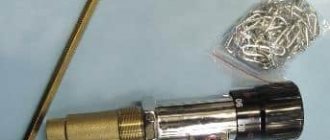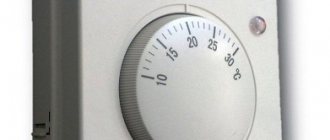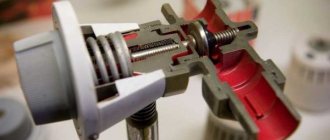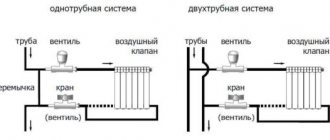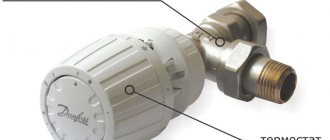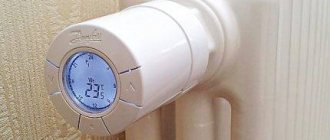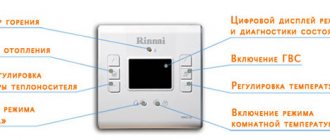Danfoss thermostats can be installed independently, but for this you need to know the direction of movement of the coolant (you can find out from the operating company) and what type of heating system you have, or rather single-pipe or two-pipe; this information can also be obtained from the operating company.
Sometimes it becomes necessary to adjust the temperature in each specific room. This can be done by installing a thermostat for the heating radiator. This is a small device that regulates the heat transfer of a heating battery. Can be used with all types of radiators, except cast iron. One important point is that the device can lower the initial temperature, but if there is not enough heating power, it cannot increase it.
How to choose a Danfoss thermostat and install it
Heating and ventilation costs average 30-50% of the family budget. And the problem is not in the function itself, but in poor energy consumption. Danfoss offered a convenient solution - a thermostat for controlling the temperature in the house and the operation of the heating system. This device can be used in combination with almost all boilers, including heating devices with liquid coolant.
The thermal head is used at home, in apartments, industrial premises, warehouses, closed greenhouses and conservatories, in a word, wherever a relatively constant temperature regime is required. Moreover, this applies not only to heating, but also to air conditioning. Thus, the thermal head interacts equally successfully with air conditioners, refrigeration equipment and other units responsible for temperature.
About company
The Danfoss company was founded in 1933.
The Danish company Danfoss A/S is an international concern producing heating and refrigeration equipment. The company was founded in 1933 and is headquartered in Norborg (Denmark).
The range includes automation equipment for heating, ventilation and air conditioning complexes of buildings. Factories produce shut-off and control valves.
Many years of experience in the design and manufacture of specialized equipment allows the company to produce competitive products. According to experts, up to 30% of thermal automation devices in Russia are supplied by Danfoss. All products comply with European quality standards.
Design features
The main purpose of the Danfoss thermostat is to long-term maintain the user-selected temperature regime. The design of the device includes two main parts:
- thermostatic element or, as it is also called, a thermostat;
- valve.
The valve is first mounted on the battery and only the thermostat is installed on it. It is the second element that is the main one in the design of the device. It monitors the ambient temperature, after which it sends the necessary signal to the valve, which in turn opens or closes the coolant flow.
Design of Danfoss thermostatic valves
In the internal area of the Danfoss thermostat there is a bellows - a corrugated container filled with gas or liquid. When exposed to temperature, the filler begins to change size and put pressure on the shut-off valve. When the coolant flow in the heating units is blocked, the temperature begins to increase.
If the room has become very cold, the filler contracts and a reverse reaction occurs - the chamber pulls the spool rod behind it, which in turn opens the gap in the valve element for coolant to flow in.
The company produces two types of thermostats - gas and liquid. But the second option is considered more inert; it gives a signal to change the temperature regime much slower.
Types and symbols of devices
The type of filler and purpose are determined by the following abbreviation:
- RTS – liquid bellows
- RTD-G - gas device for a one-pipe or two-pipe system in which there is no pump
Valve RTD-G-20 for one-pipe system
- RTD-N – gas device for single-pipe, two-pipe pumping systems
Thermostat valve RTD-N-15
In some models, in addition to the main function, there are a number of additional options. For example, a program to protect against interference in the installed settings by random persons. The option will be convenient for installation in public institutions or children's institutions. The number of modes and types of functions vary depending on the selected modification.
Model range of devices
The company produces a fairly wide range of Danfoss heating temperature controllers.
Types of shut-off valves
The most popular variations are:
- Danfoss RDT marking 3640 - the device is intended for use on standard two-pipe heating systems. It is equipped with an RTD option, which prevents freezing of the main line during the cold season. Used in domestic and industrial conditions. It has four divisions with designations in the form of Roman numerals.
- The Danfoss RAX regulator is a liquid type of device that is used for installation on designer-type radiators or heated towel rails. It has attractive external parameters and a minimalist style. On the case there are only divisions with Roman or Arabic numerals.
- Living ECO with the function of monitoring the microclimate in the house. This is an improved series that is successfully used in commercial establishments and residential buildings. The peculiarity of the thermostat for a heating radiator is that it has a liquid crystal screen that provides all the necessary information about the coolant. There are also three main mode setting keys on the case.
- The Danfoss RA-299 gas appliance with automated temperature control is available in several colors. It responds quickly to temperature changes. It is used exclusively for equipping traditional heating systems.
- 013 G4 001-013 G4 009 – multifunctional series of devices suitable for both heated towel rails and various areas of the heating device. There are left- and right-handed types.
Each of the presented options is equipped with parts that simplify the installation of the device and its subsequent use.
VIDEO: Review of Danfoss thermostatic kits
Installation of thermal head
The Danfoss thermostat is installed directly on the “hot” pipe, which supplies coolant to the domestic heating system. Installation work does not have any difficulties, even when it comes to design variations, the installation principle is the same for everyone.
The following steps must be followed:
- Make a mark on the supply pipe to determine the area that needs to be cut. In this case, take into account the dimensions of the valve body and remove the threaded element that will fit directly into the pipe.
- Turn off the heating and drain the water so as not to flood the house while working.
- Using the marks, cut off the unnecessary section of the pipe and make a thread on the outer part of the cut using a die.
- Treat the connecting part with a special plumbing paste from any manufacturer and a foam tool.
- Screw the valve element onto the thread that was made with a die, and then tighten it well with a washer. There is no need to additionally seal the joint area; this connection will be sufficient to prevent the pipe from leaking.
- Remove the fuse, set the thermostat to the maximum value of “5” and put the housing with the scale on top. The cap is put on all the way, the defining signal is a loud click, it indicates tight contact of the parts.
- Check all connections and connect the heating device back to the general heating system.
Check the operation of the Danfos regulator before opening and closing the valve device for the first time. If the installation was carried out according to the rules, there should be no problems.
How to adjust the device
Although all modifications of Danfoss thermostats have differences in external parameters and technical characteristics, setting up the devices is done using the same method. To implement this, you will need to refer to the operating instructions and study the designations of the modes indicated on the device body. Indicators may differ depending on which model is used.
Thermostatic radiator kit Danfoss G1/2
Next, set the device to the desired temperature setting. To do this, move the torque element to the required mode. If a device with push-button control was installed, all manipulations are carried out by pressing the “increase” or “decrease” temperature keys.
You can also choose an intermediate parameter if it is more suitable for creating a specific microclimate in the house. After a few minutes, the heating system will adjust to the selected values and will heat the room until the desired microclimate is achieved. The valve is adjusted in a similar way for refrigeration units.
VIDEO: How to properly install a thermal head on a radiator
Tips before you start installing your thermostat
We suggest that you familiarize yourself with the following tips that you should remember before installing the device.
Before installing the locking and regulating mechanism, you should familiarize yourself with the manufacturer's recommendations. The design of temperature controllers contains fragile parts that can fail even with a slight impact. Therefore, care and attention should be exercised when working with the device. It is important to consider the following point - the valve must be installed so that the thermostat takes a horizontal position, otherwise warm air coming from the battery may enter the element, which will negatively affect its operation. There are arrows on the body that indicate in which direction the water should move. When installing, the direction of the water must also be taken into account. If the thermostatic element is installed on a single-pipe system, then bypasses must be installed under the pipes in advance, otherwise if one battery is disconnected, the entire heating system will fail. Semi-electronic thermostats are mounted on batteries that are not covered with curtains, decorative grilles, or various interior items, otherwise the sensor may work incorrect
It is also advisable to place the thermostatic sensor at a distance of 2-8 cm from the valve
Semi-electronic thermostats are mounted on batteries that are not covered with curtains, decorative grilles, or various interior items, otherwise the sensor may not work correctly. It is also advisable to place the thermostatic sensor at a distance of 2-8 cm from the valve.
The thermostat is usually installed on a horizontal section of the pipeline near the point of entry of the coolant into the heating device
Electronic thermostats should not be installed in the kitchen, in the hall, in or near the boiler room, since such devices are more sensitive than semi-electronic ones. It is advisable to install devices in corner rooms, rooms with low temperatures (usually these are rooms located on the north side).
When choosing an installation location, you should be guided by the following general rules:
- There should be no devices near the thermostat that generate heat (for example, fan heaters), household appliances, etc.;
- It is unacceptable for the device to be exposed to sunlight and for it to be located in a place where there are drafts.
By remembering these simple rules, you can avoid a number of problems that arise when using the device.
Danfoss thermostat: principle of operation, instructions, reviews
In many countries, up to 40% of energy resources are spent on the needs of ventilation and heating of buildings. This is several times more compared to advanced European countries.
Need for use
The issue of energy saving is especially acute; this is relevant against the backdrop of a constant increase in energy prices. One of the devices that allows you to save thermal energy is a thermostat for radiators; its installation reduces heat consumption by 20%. To do this, the consumer needs to choose the right design for the heating system, as well as carry out installation, you can find out about this by reading below.
Principle of operation
The Danfoss thermostat is designed to maintain a constant indoor temperature. Such devices were first used back in 1943. The mentioned company is a market leader in the production and sale of such units. Structurally, the devices consist of 2 main elements, namely a thermal head and a valve, which are connected by a locking mechanism. The purpose of the thermal head is to determine the ambient temperature in order to regulate the effect on the actuator, the latter being a valve. It is designed to cover the flow of water that enters the radiator. This method of regulation is called quantitative, since the device can affect the flow of water that passes into the battery. There is another method, called qualitative, with its help the temperature of the water changes in the system. This is done through a temperature controller, namely a mixing unit. This element must be located in the heating point or boiler room. The Danfoss thermostat has a bellows inside, which is filled with a heat-sensitive medium. It can be gas or liquid. The latter type of bellows is easier to manufacture, but does not operate as quickly as its gas counterparts, which is why the latter have become so widespread. When the air temperature level increases, the substance that is in a confined space acquires a more impressive volume; the bellows, stretching, affects the valve stem. The latter is moved downwards by a cone, which is designed to reduce the flow area. This allows you to effectively reduce water consumption. When the air temperature drops, this process occurs in the reverse order, and the volume of coolant increases to the optimal limit, which is how the Danfoss thermostat works.
Consumer Reviews
Depending on what type of heating system is used, as well as what the installation technology is, thermal heads and valves can be used in different combinations to control the flow of water. If we are talking about a single-pipe system, then a valve should be used, which is characterized by increased throughput and low hydraulic resistance. According to users, the same recommendation can be used in the case of a two-pipe gravity system, where water circulates naturally and is not influenced by force. If you decide to choose a Danfoss thermostat, you can install it on a two-pipe system that is equipped with a circulation pump. Moreover, according to reviews, the valve should be able to adjust the capacity. This adjustment is quite simple, and there is no need to use a special tool for this. Once you have decided which valve to use, you should decide on the type of thermal head.
Additional consumer recommendations
If you are interested in a Danfoss thermostat, the installation instructions for which will be presented below, you can purchase it at an affordable price. When determining the type of thermal head, you should know that it is offered for sale in some varieties. Thus, there may be a thermocouple inside. Among other things, the temperature sensor can be remote. Sometimes the regulator is external. Devices can also be programmable, in which case they are electronic. You can also choose a vandal-proof thermal head. According to users who have chosen a regulator with an internal sensor, this device should be installed only if it is possible to position it horizontally. Then the air in the room will flow freely to the body of the device.
For reference
After you have purchased a Danfoss radiator thermostat, you should familiarize yourself in more detail with the features of its installation. Thus, it is completely unacceptable to install it on a radiator in a vertical position. In this case, the heat flow will constantly rise upward, and increased temperatures from the supply pipeline and housing will affect the bellows. Ultimately, you will encounter the device not working correctly.
Customer reviews on choosing a thermostat
Home craftsmen especially emphasize that in some cases it is not possible to install the device horizontally. Then it is recommended to buy a remote temperature sensor, which comes complete with a capillary tube. The length of the device is 2 meters. It is recommended to place the device at this distance from the battery by installing it on the wall. Buyers emphasize that the inability to install the regulator horizontally does not always indicate the need to purchase a remote sensor. There may be other objective reasons for this. The Danfoss thermostat, the operating principle of which was described above, cannot be installed behind thick curtains; in this case, of course, the best solution would be to purchase a remote sensor. Among other things, such a need arises when there is a heat source near the thermal head or hot water supply pipes pass. You can resort to this solution even when the radiator is located under a sufficiently wide window sill. In this case, the thermoelement may fall into the draft zone. Buyers claim that if at least one of the above conditions is met, then it is best to purchase a remote sensor.
Installation instructions
The Danfoss thermostat, reviews of which are presented in the article, must be installed using a certain technology. The first recommendation is to avoid installing the thermal head on the heater within sight. Batteries whose total power is equal to 50 percent or more of all that are in the same room should be regulated. Thus, when there are two heating devices in the room, the thermostat should be on one battery, whose power is more impressive. If you are interested in Danfoss - a thermostat, the setup of which is quite simple, you can purchase and install it. The first part of the device, which acts as a valve, should be installed on the supply pipeline. If it needs to be inserted into an already assembled system, the supply line must be dismantled. This work may involve some difficulties if the connection is made using steel pipes. The master will have to stock up on tools for cutting the material.
Conclusion
Danfoss is a fairly popular company on the market for relevant products today. The thermostat (how to regulate it is indicated in the instructions) must be installed on the radiator. The thermal head is then mounted without the use of additional tools. This is very easy to do at home, in addition, you will be able to save on purchasing consumables.
Thermal valve - structure, purpose, types
The valve in the thermostat is very similar in structure to a regular valve. There is a seat and a shut-off cone that opens/closes the gap for coolant flow. The temperature of the heating radiator is regulated in this way: by the amount of coolant passing through the radiator.
Sectional view of thermostatic valve
The valves are installed differently for one-pipe and two-pipe wiring. The hydraulic resistance of a valve for a one-pipe system is much lower (at least two times) - this is the only way to balance it. You can't mix up the valves - it won't heat. For systems with natural circulation, valves for single-pipe systems are suitable. When installing them, the hydraulic resistance, of course, increases, but the system will be able to work.
Each valve has an arrow indicating the movement of the coolant. During installation, it is installed so that the flow direction coincides with the arrow.
What materials?
The valve body is made of corrosion-resistant metals and is often additionally coated with a protective layer (nickel or chrome plated). There are valves from:
- bronze (nickel and chrome plated);
- brass (coated with a layer of nickel);
- of stainless steel.
Cases are usually brass or bronze with nickel or chrome plating
It is clear that stainless steel is the best option. It is chemically neutral, does not corrode, and does not react with other metals. But the cost of such valves is high and it is difficult to find them. Bronze and brass valves have approximately the same service life. What is important in this case is the quality of the alloy, and it is carefully monitored by well-known manufacturers. Whether or not to trust unknowns is a controversial issue, but there is one point that is better to keep track of. There must be an arrow on the body indicating the direction of flow. If it is not there, then you have a very cheap product that is better not to buy.
By method of execution
Since radiators are installed in different ways, the valves are made straight (through) and angular. Choose the type that will work best for your system.
Straight (way through) valve and angle
| Name/Company | For which system | Du, mm | Housing material | Operating pressure | Price |
| Danfos, angular RA-G, adjustable | single-pipe | 15 mm, 20 mm | Nickel plated brass | 10 bar | 25-32 $ |
| Danfos, direct RA-G with customizability | single-pipe | 20 mm, 25 mm | Nickel plated brass | 10 bar | 32 — 45 $ |
| Danfos, angular RA-N, adjustable | two-pipe | 15 mm, 20 mm. 25 mm | Nickel plated brass | 10 bar | 30 — 40 $ |
| Danfos, direct RA-N with customizability | two-pipe | 15 mm, 20 mm. 25 mm | Nickel plated brass | 10 bar | 20 — 50 $ |
| BROEN, direct fixed tuning | two-pipe | 15 mm, 20 mm | Nickel plated brass | 10 bar | 8-15 $ |
| BROEN, direct fixed tuning | two-pipe | 15 mm, 20 mm | Nickel plated brass | 10 bar | 8-15 $ |
| BROEN, corner, adjustable | two-pipe | 15 mm, 20 mm | Nickel plated brass | 10 bar | 10-17 $ |
| BROEN, corner, adjustable | two-pipe | 15 mm, 20 mm | Nickel plated brass | 10 bar | 10-17 $ |
| BROEN, direct fixed tuning | single-pipe | 15 mm, 20 mm | Nickel plated brass | 10 bar | 19-23 $ |
| BROEN, fixed angle | single-pipe | 15 mm, 20 mm | Nickel plated brass | 10 bar | 19-22 $ |
| OVENTROP, axial | 1/2″ | Nickel plated brass, enamel plated | 10 bar | 140 $ |
Danfoss thermostat - operating instructions
Installing a thermostat on a radiator is an opportunity to reduce heating costs, improve the microclimate in the house, and also carefully use the earth's energy resources.
The motives may be different, but the decision is being implemented more and more often.
Many people, when choosing an equipment manufacturer, choose Danfoss.
And not surprisingly, products from a well-known brand can easily be found on the shelves of many stores.
The production technology of their thermostats based on a gas-filled bellows is patented and used in the company’s own factories. If you also decide to purchase a Danfoss thermostat, the installation and operating instructions will come in handy.
The purpose of installing a thermostat is to maintain the air temperature in the house chosen by the consumer.
The design of a thermostat for radiators includes two elements that complement each other:
- Thermostat (or thermostatic element).
- Danfoss thermostat valve.
The valve is connected directly to the battery, and a thermostatic element is installed on it.
The heart of the matter is the thermostat. It is he who reacts to changes in ambient temperature and affects the valve that blocks the flow of coolant.
Inside the thermostat head is a bellows (a corrugated chamber capable of changing dimensions) filled with gas. The gas, depending on the temperature, changes its state of aggregation (when cooled, it condenses). This leads to a change in volume and pressure in the chamber. The chamber decreases in size and pulls the spool rod with it, which opens a larger gap in the valve for the flow of coolant.
When heated, a reverse process of expansion and closure of the lumen occurs (the accepted standard is 2 V ° C in excess of the air temperature above the set one).
When a comfortable temperature is set on the regulator scale, a certain compression of the tuning spring is established inside, which is interconnected with a certain gas pressure.
Danfoss produces bellows with gas inside, as well as liquid ones. The latter are more inert and react more slowly to temperature changes.
Types and symbols:
- RTS—liquid bellows;
- RTD-G - gas bellows for a one-pipe system, or two-pipe without a pump;
- RTD-N - gas bellows for two-pipe systems and systems with a circulation pump.
Radiator thermostat DANFOSS RA 2991
There are also modifications of thermoelements in which:
- Protection is provided against reconfiguration by random persons (an excellent option for public institutions and children's rooms).
- There is an external temperature sensor connected by a two-meter capillary tube, which can be installed away from the radiator, buried in a niche or filled with furniture, which gives a more accurate measurement result.
- With a temperature range slightly smaller than conventional sensors for integration into a system where payment is made according to regulations.
Floor heating system
Thermostats are also used for underfloor heating systems. A thermostat for heated floors is a must!
After all, when driving liquid into the floor contour, you need to lower its temperature from 60 - 90 V ° C to a comfortable 35 - 40 V ° C (in this case, the surface of the floor itself will be about 25 V ° C).
Flow meters are powerless if the pressure in the system fluctuates, if the air is heated, for example, from the sun, and even if residents want to save on heating while they are away.
The thermomechanical regulator is best used for small rooms, about 10 m2.
For large areas, room thermostats with heated floor temperature sensors are used.
First of all, the valve is mounted on the radiator. To do this, the coolant supply is shut off.
- Markings are made on the supply pipe. The area that will need to be cut should be the same length as the valve body minus the threaded connections.
- The heating pipe is cut and the extra section is cut out.
- Using a die, or die, a thread is made on the outside of the cut pipe.
- The connection is treated with plumbing paste and fum tape.
- The valve body is screwed onto the resulting thread.
- Since the pipe cannot be twisted, an American union nut is twisted on the opposite side of the valve, and then screwed (with a hex wrench) into the radiator hose.
- The body of the device is screwed into its own union nut through a rubber washer. This connection does not need to be sealed in any way, the main thing is that it is clean.
- After the valve is installed on the radiator, the protective cap is removed from it (located perpendicular to the pipe).
The thermal head is set to the maximum temperature value, after which it is pressed onto the valve (until it clicks).
Sensor installation
As already mentioned, a remote sensor is needed if the battery is built into the wall or covered by something (furniture, screen, thick curtains).
A sensor and a setting unit are combined in one housing of this element.
- It is best to place the device on an open (but without drafts) section of the wall, at a height of about 1.4 m from the floor. You need to avoid places near appliances that can greatly change the temperature of the environment - air conditioners, stoves, etc.
- The device comes with a small mounting panel, which is secured to the selected location using a pair of self-tapping screws.
- A capillary tube is wound inside the sensor. It is pulled out to the required length so that the device reaches the fixed bar.
- The capillary tube is carefully fixed on the back of the valve.
- The sensor is placed on the bar by simply snapping it into place.
Setting a limit
The operation of thermostats is based on physical laws. Therefore, you need to remember that the conditions in which the device is located may make some adjustments (for example, distance from the heat source). There are indicative tables of correspondence between the regulator scale and temperature, which can be taken as a guide during installation. However, after the basic setup, you will need to “understand” your thermostat.
- Set the temperature on the handle with marks.
- After an hour, control measurements are taken with a room thermometer at several points in the room.
- If the temperature is higher or lower, the readings on the handle are adjusted.
Proportional band - 2 °C. If you set the temperature to 20°, the device will maintain readings in the range from 20 to 22 °C.
Sensor after installation on the radiator
The two pins that are included with the sensor will help set the limits for the minimum and maximum positions of the thermoelement.
They are located at the bottom of the device:
- To set the limit to o, you need to pull out the limiter and set the sensor readings to o. Then the pin is inserted into the hole, which in this position is under the diamond icon.
- The second limiting threshold is set in the same way. The handle is turned to the desired value, only the pin is inserted into the hole located under the triangle icon.
You can block the regulator at a certain temperature (protects against accidental failure or childish pranks).
- Both pins are removed.
- The handle is placed at the desired level.
- In this position, the first pin is inserted into the hole located under the diamond.
- The second pin goes into the hole under the triangle.
Danfoss thermostats have many positive reviews. This is a very easy to use device that does not require any attention after initial installation and configuration. But the result will be a more comfortable temperature in the apartment, and in some cases, significant budget savings.
Video on the topic
How to adjust (reconfigure)
All thermostats are factory adjusted. But their settings are standard and may not match your desired parameters. If you are not satisfied with something in the work - you want it to be warmer/colder, you can reconfigure the thermostat for the heating radiator. This must be done with the heating running. You will need a thermometer. You hang it at the point where you will control the state of the atmosphere.
- Close the doors, put the thermostat head in the extreme left position - completely open. The room temperature will begin to rise. When it becomes 5-6 degrees higher than what you want, turn the regulator all the way to the right.
- The radiator begins to cool down. When the temperature drops to a value that you consider comfortable, begin to slowly turn the knob to the right and listen. When you hear the coolant making noise and the radiator starting to warm up, stop. Remember what number is on the handle. It will need to be set to achieve the required temperature.
Adjusting the thermostat for a radiator is not difficult at all. And you can repeat this action several times, changing the settings.
Installing a thermostat on a radiator is an opportunity to reduce heating costs, improve the microclimate in the house, and also carefully use the earth's energy resources.
The motives may be different, but the decision is being implemented more and more often.
Many people, when choosing an equipment manufacturer, choose Danfoss.
And not surprisingly, products from a well-known brand can easily be found on the shelves of many stores.
The production technology of their thermostats based on a gas-filled bellows is patented and used in the company’s own factories. If you also decide to purchase a Danfoss thermostat, the installation and operating instructions will come in handy.
Selection of thermostats for heating radiators
Thermostats installed on heating radiators can increase indoor comfort, as well as significantly save on heating costs when it comes to a private home.
There are several types of devices on the market: electronic, mechanical, gas-filled, liquid, as well as with remote or built-in temperature sensors. Our material is devoted to how to select and install thermostats, what you should pay attention to first.
Types of control elements
Electronic automatic thermostat Danfoss
Installing a shut-off and control valve or valve in front of the heating radiator is a measure that serves not only to regulate the flow of water into the battery, but also an issue of emergency safety, since it becomes possible to disconnect the battery from the common riser, if necessary. Such a simple and important function was not always provided for in heating systems before; by the way, not all new houses have battery-operated shut-off valves installed.
The following are used as locking and regulating elements:
- ball valve,
- cone valve,
- automatic thermostat.
Ball valve
This is the most minimal measure aimed at creating the possibility of emergency shutdown of radiators. This element performs only a locking function, since the design provides only two positions - “open” or “closed”.
Regulating the heating of the battery using a ball valve is an ineffective practice, since the valve in the middle position is vulnerable to the damaging effects of solid particles. The coolant circulating in the system contains suspensions, rust particles and other foreign small elements (this is especially typical for heating systems of apartment buildings).
Gradually, the surface of the faucet will deteriorate, jagged marks will remain on the shut-off ball, which means that sooner or later it will become unsuitable for performing its main function - locking, since the tightness will be broken.
Cone valve
Allows you to regulate the flow of coolant into the radiator, so you can use it to regulate the temperature. In general, installing a manual cone valve in front of the batteries is an inexpensive and functional solution.
The disadvantage in this case will be the complete absence of any markings for adjustment; you will have to independently determine how much to change the position of the valve, do not forget to return it to its original position, etc.
Thermostats with thermostat
The most modern and comfortable solution is to install a thermostat with a thermostat in front of the radiator, which allows you to accurately regulate the degree of heating of the battery, and therefore the air temperature in the room.
Types of thermostats
Today, two types of thermostats are used:
Thermostat design
The device and main components of the thermostat
The radiator thermostat has two parts:
- Valve
- Thermostatic element
The thermostatic element is a hollow cylinder, the walls of which are corrugated, this cylinder is called a bellows. The bellows is filled with a substance (water or gas) that can react to fluctuations in air temperature in the room.
When the temperature rises, the volume of the working substance increases, pressing on the walls of the bellows. The bellows moves the rod, which closes the valve. The valve controls the amount of coolant entering the battery. When the valve stem moves, the flow of coolant decreases.
Types and design of decorative screens and grilles for batteries, detailed review
Connecting radiators - detailed diagrams and practical recommendations
The photo shows types of thermostats
If the air temperature in the room decreases, then the volume of the working substance decreases; it no longer stretches the bellows, thereby opening the valve and increasing the flow of coolant.
Bellows have a large margin of safety and service life; they can withstand hundreds of thousands of compression cycles for decades. (Danfoss cites data that their bellows can last up to 100 years, having completed 1 million cycles).
Gas-filled thermostats
Gas-filled thermostats are manufactured by the Danish company Danfoss; they are reliable equipment that has a service life of over 20 years. The bellows system of the gas-filled thermostatic element, as indicated above, is filled with gas, this allows you to smoothly regulate the air temperature in the room.
The sensor detects the ambient air temperature. Each temperature corresponds to a certain level of gas pressure in the bellows, which is balanced by compression of the adjusting spring.
As the room temperature rises, the gas pressure in the bellows increases and the valve cone moves towards closing. This process continues until equilibrium is restored between the gas pressure in the bellows and the compression of the spring. When the air temperature in the room drops, the gas pressure decreases, as a result of which the bellows compresses and the valve cone moves towards opening until the system reaches equilibrium.
Danfoss devices
Examples of Danfoss automatic thermostat models
Temperature regulators of the RTD series from Danfoss are gas-filled devices.
This technical design gives two serious advantages at once:
- The gas condenses in the cold half of the sensor, which is further away from the control valve. In this case, the radiator thermostat will always detect temperature fluctuations in the room, and the influence of the water temperature in the pipe will be eliminated.
- The thermostat is very sensitive and is able to respond extremely quickly to temperature changes, so it controls the flow of heat into the room as efficiently as possible.
Danfoss produces two types of thermostats for radiators:
In addition, they can be straight or angular.
The type of regulator is selected based on the type of heating system in the house, and the size of the valve is selected based on the diameter of the pipe supplying the coolant or the diameter of the hole in the plug of the heating device.
Valves type RTD-G in thermostats use:
- For single-pipe heating systems;
- For two-pipe heating systems in apartment buildings;
- For two-pipe systems, without installing circulation pumps, in cottages.
RTD-N type valves in thermostats are used:
- For two-pipe heating systems in new buildings;
- For two-pipe heating systems of cottages in which circulation pumps are installed.
Average prices for Danfoss thermostats (Danfoss)
The table shows the average prices at which you can currently buy thermostats for Danfoss heating radiators (Denmark).
The model number and a short technical description are provided, the cost is indicated in rubles (may vary depending on the exchange rate).
Types of thermal heads
- manual;
- electronic;
- mechanical.
They all perform the same function, only the operating principle differs.
Manual thermal heads are similar in appearance to a faucet. By turning the regulator, the desired value of the coolant is achieved. They are installed instead of classic ball valves. They are distinguished by their reliability and low cost. The downside is the inaccuracy of settings and inconvenience of use. Also, the regulator may become loose due to frequent use.
Mechanical thermal heads have a more complex design. In this case, the set temperature is maintained automatically. It is based on a bellows in the form of a cylinder, inside of which there is an agent in a liquid or gaseous state. When the temperature rises above the stated norm, the rod begins to move. The channel cross-section narrows, the throughput decreases and the temperature drops to the declared value. The advantages of mechanical regulators include ease of use, accuracy of settings and automatic mode adjustment. Disadvantage: higher cost.
Electronic
Thermostatic elements
The thermal head for a Danfoss heating radiator reacts to the temperature in the room. The thermostatic element will open the thermostat valve if the room is cool and close it if it gets too hot. Prices, technical specifications and operating instructions for equipment are presented in the catalogue. Choose a model that will provide you with economical energy consumption and will allow you to avoid open windows and drafts.
- Free shipping
- Expected delivery 07/27/2018
Advantages of our products
The lineup
Danfoss has been producing regulators since 1943. Since 2009, a single series of thermostats for radiators, designated by the RA index, has been launched.
In 2016, the company presented a line localized for the Russian market with the designation RTR. The devices are adapted for operating conditions in heating plants in our country, taking into account the quality of the coolant and hydraulic pressure parameters.
When purchasing regulators, be sure to take into account the information contained in the instructions for the Danfoss automated heating regulator.
Control valves type RTR:
- Devices for a two-pipe system with pumps - RTR-N, with increased resistance. The device includes an installation adjustment device for performing hydraulic balancing of the heating system.
- RTR-G valves with increased flow capacity for pump single-pipe or two-pipe gravity heating systems.
In apartments and private houses, the most popular series of devices is the RTR7000, which includes the following devices:
- RTR 7090 and 7091 with built-in temperature sensor and temperature adjustment from 5 to 26 °C, series 7091 can be adjusted to 0 °C.
- RTR 7092 are equipped with a remote sensor* and a device for fixing the minimum and maximum temperatures (travel limiter).
- RTR 7094 - protected from unauthorized intervention, built-in sensor that prevents freezing.
- RTR 7096 is protected by a special casing, has temperature control restrictions, and the sensor in the device is remote*.
The remote sensor is connected to the device with an ultra-thin tube up to 2 m long.
Liquid filled sensors are designated RTRW.
When replacing sensors of older RTD and RA series with RTR devices, use the table.
| New episode | Equivalent | |
| RTR 7090 | RA 2994 | RTD 3640 |
| RTD 3110 | ||
| RTD-R | ||
| RTD 7092 | RA 2992 | RTD 3642 |
| RTD 3120 | ||
| RTD 7094 | RA 2920 | RTD 3120 |
Options for replacing rarer regulators can be found in the appendix to the instructions.
Save up to 46% energy
Radiator thermostats allow you to spend exactly the amount of energy that is needed at the moment to maintain a comfortable temperature in the room. Different thermostatic elements cope with this task in different ways. Compared to a manual control valve, liquid or paraffin filled thermostats save 31%, and gas filled thermostats save 36%. Using Danfoss living eco electronic radiator thermostats allows you to save up to 46% of heating energy.
*According to a study conducted by the RWTH, Aachen, Germany.
Floor heating system
Thermostats are also used for underfloor heating systems.
A thermostat for heated floors is a must! After all, when driving liquid into the floor contour, you need to lower its temperature from 60 - 90 V ° C to a comfortable 35 - 40 V ° C (in this case, the surface of the floor itself will be about 25 V ° C).
Flow meters are powerless if the pressure in the system fluctuates, if the air is heated, for example, from the sun, and even if residents want to save on heating while they are away.
The thermomechanical regulator is best used for small rooms, about 10 m2.
Fast reaction
Danfoss RA series thermostats are equipped with a gas-filled bellows. The heat capacity of gas is significantly less than that of liquid and, especially, paraffin. As a result, gas-filled thermostats respond much faster to changes in room temperature. Therefore, Danfoss thermostats maintain temperature with greater accuracy and provide greater energy savings. Radiator thermostats with a gas-filled thermostatic element (“gas”) are patented and manufactured only by Danfoss.
Major breakdowns
A device such as a ball bathroom faucet may have the following breakdowns:
- liquid flows out of the tap;
- water pressure is weak;
- The water temperature is not set correctly.
Ball valve device.
The reason why water pressure decreases may be a clogged faucet. To eliminate this problem, install a special filter in front of the mixer. Liquid leaks, as a rule, because the gap between the rotating element and the rubber gaskets in the cartridge is clogged. The tightness of the installation can be compromised even by a small grain of sand.
Repair in this case consists of the bathroom and cleaning the clogged area. Otherwise, the leak will only worsen, since even a small grain of sand will completely ruin the rubber gasket over time. Due to a strong change in water temperature, one of the holes may become clogged with rubber pieces from the gasket or sand particles.
If it is impossible to determine the cause of the breakdown, then repairs are necessary completely for the bathroom.
Some people buy faucets at quite low prices. Such products are made from cheap silumin. It is completely unreliable and can break even with a small mechanical impact. This type of crane cannot be repaired. It is better to purchase a high-quality, inexpensive model once.
Common Mistakes
Correct installation requires attentiveness from the master at every stage of work in order to avoid mistakes. The most common problem is the vertical position of the head. This leads to the fact that the room stops heating, since the thermostat itself heats up from the incoming air.
Often the wrong installation location is chosen. You cannot install the regulator at a point where the air temperature is very different from the average in the room. Due to the wrong choice of installation location, the use of a thermal head loses its meaning.
Regulator design
The design of the heating regulator for the battery includes the following elements:
- valve or valve;
- thermostatic mechanism.
Control device design
A thermostat or thermal valve is a standard valve in a housing with a control mechanism.
The cone is considered a locking element, which, when moving, changes the amount of coolant.
The movement of the cone is facilitated by a thermal head, consisting of a cylinder with a thermal component.
The cylinder is called a bellows, and a special liquid or gas is used as thermal components.
When heated, this component expands in volume and tightens the cylinder, which moves the conical part.
The cone blocks the flow of coolant and the composition cools down.
At the same time, the bellows becomes smaller.
Then the cone rises, and the liquid moves into the battery and helps heat the thermal head of the equipment.
This technique allows you to maintain the desired temperature.
The structure of a thermostatic head for radiators. Arrows indicate the components of the device.
When the temperature drops below the set value, the bellows filler decreases in volume and the opposite process to that described above occurs. The coolant circulation increases and the room temperature rises to the desired value.
